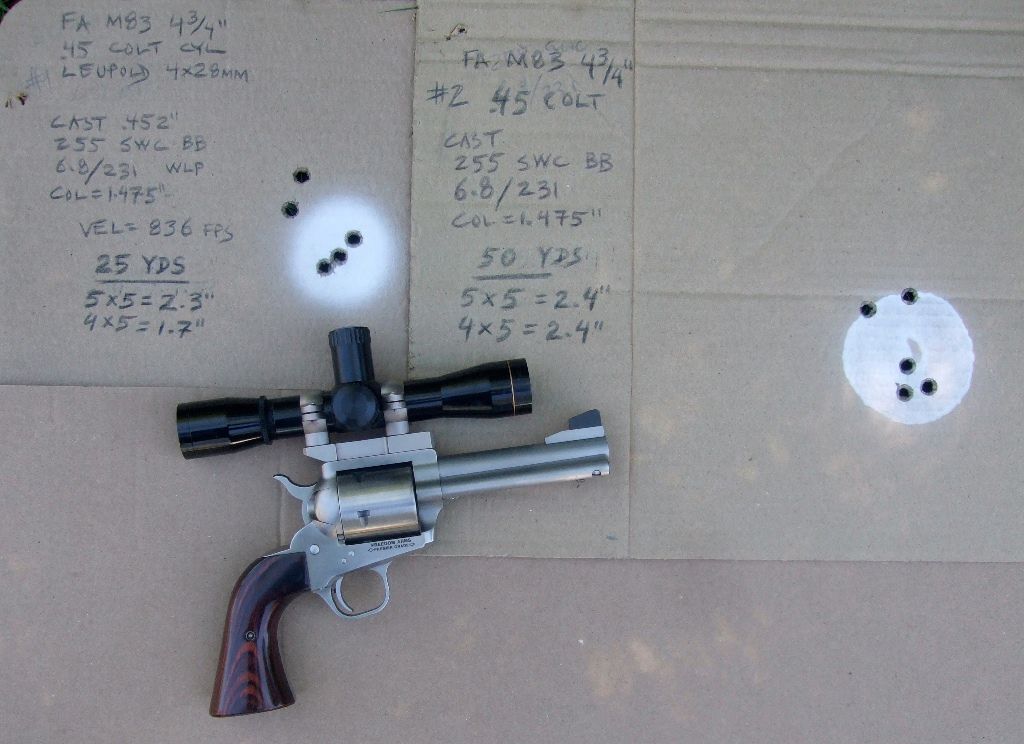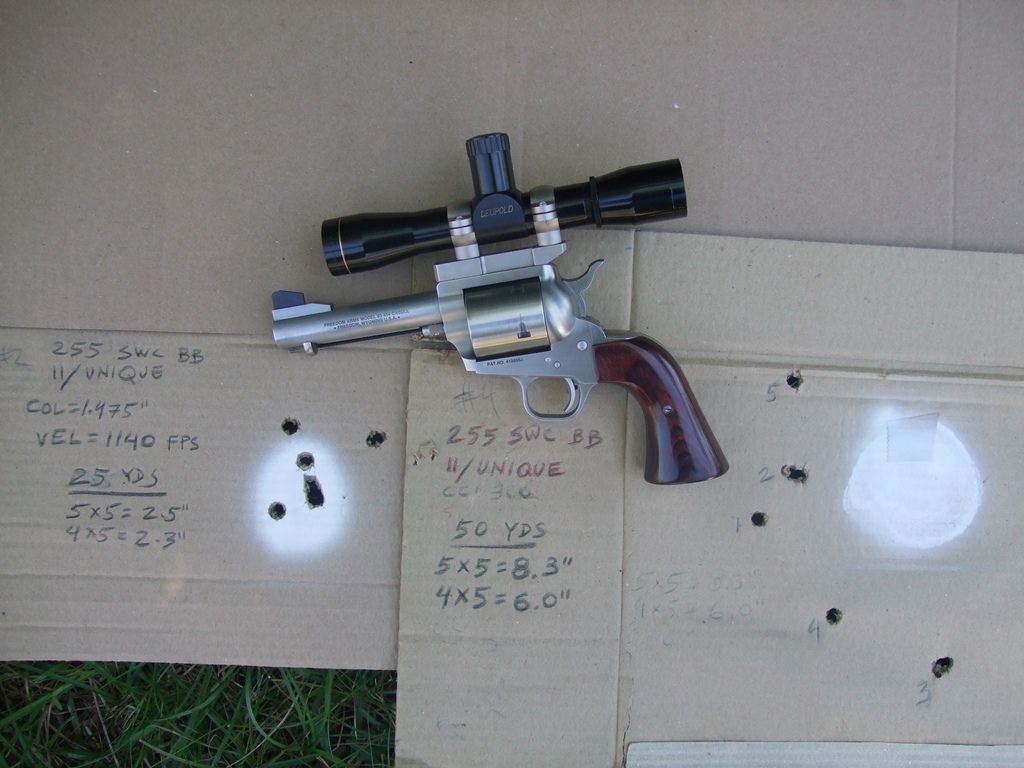|
|
Post by Lee Martin on Oct 19, 2014 18:07:06 GMT -5
A few .45 Colt loads with commercial cast bullets produce mixed results; old hands on Singleactions well aware all bullets NOT created equal. Especially at issue, dreaded Bevel Base commercial mass cast slug. Issue far from simple, with wheelbase and nose profile ready to queer the deal at any moment. We start with a cast 255 grain Semi Wad Cutter, Bevel Base, pushed 800+ fps. Freedom Arms Model 1983 4-3/4" with .45 Colt cylinder. 255 SWC BB, 6.8/ 231, Deep seated COL=1.475"  Now kick same .452" 255 SWC BB to 1130-1140 fps over 11 grains/Hercules Unique. Upon this target @25 yds one bullet keyholes perpendicular, while another, at 2 o'clock, yaws horribly----incipient keyhole. While at 25 yards group represents 2.5-inches, by 50 yards group trombones to 8.3-inches.  Having traversed a mere 25 yds, commercial cast .452" 255 SWC BB propelled by 11/Unique cannot help but keyhole one out of five. Ominous by any measure, it cannot get better from here. Weather sensitivity is attributable to velocity or pressure at muzzle matters less than demonstrable superiority of a plain base cast bullet. Manufacturers should move up to current century to recognize not all shooting is done across a card table.  Defunct Northeast Bullets of Maine produced .452" 300 grain Truncated Cone Bevel Base, which shoots reasonably well. Bullets remains very low on list of profiles preferable for actual killing of game, where immediate performance trumps billboard graphics. To put it country simple, accuracy exceeds anticipated punch.  Commercial cast 250 Round Nose Flat Point mercifully enjoys minimal bevel base. Bullet below 850 fps survives very well through 50 yards. But it is not a slug with which we trust to play hard corps at 100 yards. 19th century profile may preclude modern consideration. I do not want to shoot a deer with this slug; hungry, there would be no hesitation. Groups at 25 and 50 yards are nearly interchangeable, imparting credibility for regular tasks. Accuracy slops by 100 yards.  Cast .452" 250 grain Round Nose Flat Point at 50 yds maintains reasonable accuracy for directing the bullet in your eye. Humble opinion suggests mass must shift rearward for prolonger flight stability.  -Lee www.singleactions.com"Building carpal tunnel one round at a time" |
|
cmillard
.375 Atomic
   MOLON LABE
MOLON LABE
Posts: 1,996
|
Post by cmillard on Oct 20, 2014 4:43:37 GMT -5
nice write up. good shooting. bradshaw, how does that 10" shilen barreled .44 mag of yours do with similar bullets?
|
|
|
|
Post by bradshaw on Oct 23, 2014 13:14:14 GMT -5
cmillard.... reckon someone----that someone being you----had to kick open once again the door to the .44 vs .45 debate. Don't take it personal, as beyond the notorious fraying of this rivalry, there are truths yet to be faced up to. Within the realm of exterior ballistics, plenty of mystery remains to be sorted. Exterior ballistics begins with interior ballistics, the zone between firing pin fall and bullet exit at the muzzle.
Let us start with the .45 Colt; with heraldic authority packed into the amazingly compact Colt Peacemaker, and with a case measuring 1.285", the 1973 .45 Colt shall always be the prototypical magnum revolver cartridge. Smith & Wesson's .357 Magnum of 1935 borrowed the same case length, as did the S&W/Remington .44 Magnum twenty years later. Around 1964, S&W put its fingerprints on the .41 Magnum. These magnums were born same length as the Colt case.
Never mind .005-inch here or there, factory cases for any of these rounds can vary .005", or more.
On principle a short aft case tends to exhibit better intrinsic accuracy than a longer case of same diameter. Example: .308 vs .30-06; the .308 Winchester exhibits finer intrinsic accuracy than the .30-06 Springfield. Just does. From a hunting standpoint, particularly with bullets of 180 and heavier, performance of the .30-06 tops the .308. As an addendum, both of these rounds carry high intrinsic accuracy. But, if you'll building a match rifle, match accuracy is more predictable from the .308.
No, the irony is that the .357, .44, and .41 mags come with high intrinsic accuracy. To put it country simple, all sorts of loads in these cases very straight. While the .45 Colt tends to be a picky eater; you got to cocktail loads, or bullet/powder/charge weight combinations, more exactly.
Which brings us to the .44 vs .45 shooting similar bullets caper. Take a .430" 240 SWC and similar .452" 255 SWC from the same commercial caster, both with Bevel Base. The .44 is much more likely to be accurate beyond 25 yards, in fact well beyond 100 yds. Haven't put my finger on "why?"
From the Freedom Arms Casull .44 Mag re-barreled to my specs by Jim Stroh with 10" 1:16 twist Shilen barrel, commercial cast .430" 240 SWC BB deep-seated over 5.5/HP-38 (or namesake Win 231), collects five shots in 4-inches @ 100 yds. Haven't checked velocity from the FA with 10" Shilen, but it runs 800 fps from my old and damn accurate S&W 4" M-29. Deep-seat same bullet over 10.6/HS-6 for 1050 fps from the 4-inch Smith, and same bullet thusly pushed a little harder collects five shots in 5.5" from the FA/Shilen. Pretty good.
Not so lucky, the .452" 255 SWC BB from same manufacture in .45 Colt. Got to water it down for accuracy. Push it much over 800 fps and bullets----not all of 'em, just some of 'em----yaw and eventually keyhole.
A little example of what we're talking about.
David Bradshaw
|
|
cmillard
.375 Atomic
   MOLON LABE
MOLON LABE
Posts: 1,996
|
Post by cmillard on Oct 23, 2014 22:11:24 GMT -5
I like that .44 mag write up with that 10" shilen barrel. in fact, someday, I would like to do something similar, but use a flat top bisley as a basis but do a 5 shot cylinder in .41 mag with a long cylinder as well. also with a quick twist pac nor or whomever does .41 barrels. also would like to use similar bullet molds as lee did in his .41 mag write up with heavy bullets. I think there MAY be a ballistic advantage with those long, heavy .41 bullets as compared to say a .44 or .45 of the same weight.
|
|
|
|
Post by bradshaw on Oct 27, 2014 14:23:12 GMT -5
cmillard.... reckon you want a custom .41 Magnum. As a rule, smaller bores exhibit a trajectory advantage over larger bores----providing you hike ballistic coefficient and keep velocity up. To drive a heavy smaller diameter bullet takes more pressure than to drive a thicker same-weight projectile. A five shot .41 should be extraordinarily strong. A long cylinder would allow a pointed bullet, while preserving boiler room. In the presence of a low ballistic coefficient, twist remains relatively uncritical. As BC goes up, the range of accurate twists narrows.
It will take a long, heavy .41 bullet to equal the BC of the Hornady .358 200 grain Spire Point. Take a Hornady .358 200 Round Nose and the 200 Spire Point, start them @ 1,300 fps. The Spire Point hits the ram @ 200 meters 100 fps faster than the Round Nose. That is, providing the Spire Point does not yaw. From the .357 Maximum, the 200 SP needs a 1:14" twist. The 200 RN is fine with 1:16".
Before Ruger developed the .357 Maximum, I trimmed .38 Special brass to crimp the Hornady 200 Spire Point in the cannelure an fire in the Colt Python, which has a rather short cylinder. The bullet stabilized, or so it seemed, passing through the Python's 1:14" twist. Combination of long, heavy bullet in very small boiler room, Python cylinder, and generous cylinder gap severely limited velocity. Had I a Ruger Blackhawk .357 Mag at the time, case would have been fed more 296/H110. While the Hornady 200 Round Nose worked better, I refrained from leaning on it, too.
The late Ed Verge, master at handgun and rifle, packed an M-57 8-3/8" for years. Killed his share of game, almost all by single shot, and he made some very difficult shots. Eventually he grew tired of slinging the .41 Mag from his hip. On one of our trips to Smith & Wesson, Verge had his M-57 fitted with .44 Mag cylinder and 6-1/2" M-29 barrel. How much the 6-1/2" M-29 on my hip may have influenced the switch, he never let on, and I never asked. I really couldn't see a difference on deer, and certainly not on livestock, between the effect of Verge's cold marksmanship with either .41 or .44 mag.
Smith & Wesson shortened the 1:20" twist of their .44 to 1:18-3/4" for the .41 Mag. Believe Freedom Arms uses 1:14" on their M83 .41 Mag. Look up some of John Taffin's work on the .41, likewise Lee Martin. And, to judge by former silhouetters on this forum, other worthies may chime in.
David Bradshaw
|
|
cmillard
.375 Atomic
   MOLON LABE
MOLON LABE
Posts: 1,996
|
Post by cmillard on Oct 27, 2014 22:36:48 GMT -5
would a freedom arms silhouette model be the better route for a .41? or a BFR and take off the barrel/cylinder and have it redone? I had a 657 smith that smith and Wesson was unwilling to work on--the bore looked horrible!!! it shot mediocre. that turned me off to smith and Wesson and ended up getting rid of it.
|
|
|
|
Post by bradshaw on Oct 30, 2014 15:57:55 GMT -5
cmillard.... a Freedom Arms Casull revolver represents the closest thing to guaranteed accuracy available in a production revolver. A good Dan Wesson or very good Smith & Wesson or very very good Ruger shadows the Freedom Arms but, the percentage of super shooters from the other makers is far lower. FA accuracy comes not from a barrel superior to a proper Dan Wesson, S&W, or tight-groove Ruger, but from adherence to minimal tolerances and relationship of cartridge monitoring parts laid out by Dick Casull. To put it country simple, Freedom Arms has maintained fantastic quality control since day one. No one else has come close.
Perhaps I should include the Magnum Research BFR in this assessment, but without personal experience I cannot.
The top revolver smiths know the tolerance and fit-up game, which justifies the Pavlovian response their guns inspire. If you have your sights set on a .41 Magnum, you'll have a hard time besting it. Against whatever else has been said about the S&W M-57, my experience suggests it shares aspects of a rifle. Thus, I am far from qualified to condemn it. Obviously, the Smith must not be super charged.
Seems you have chosen the .41 Mag. Cartridge is always the place to begin. Now select the action by which you will carry it and deliver the goods.
David Bradshaw
|
|
cmillard
.375 Atomic
   MOLON LABE
MOLON LABE
Posts: 1,996
|
Post by cmillard on Oct 30, 2014 22:20:44 GMT -5
I just really like the .41 mag round and with the heavy bullets (heavier than 265), it offers potential for long(er) range than some shoot their revolvers. I like that FA offers the silhouette model with a 10" barrel and 5 shot. looks like the cylinder--from what I can judge in the photos--looks to be long and fills the frame window, which would allow the long heavy bullets.
|
|














